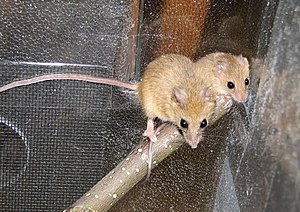Maroon climbing mouse
| Maroon climbing mouse | ||||||||||||
|---|---|---|---|---|---|---|---|---|---|---|---|---|

Dendromus mystacalis |
||||||||||||
| Systematics | ||||||||||||
|
||||||||||||
| Scientific name | ||||||||||||
| Dendromus mystacalis | ||||||||||||
| Heuglin , 1863 |
The maroon climbing mouse ( Dendromus mystacalis ) is a species of African climbing mice that is native to the tree and shrub savannas of large parts of Africa.
description
The maroon climbing mouse reaches a body length of 5 and 8 centimeters and a tail length of 7 to 10 centimeters. It weighs between 8 and 15 grams. The females are smaller and lighter than the males. The long and hairless tail, like the narrow front feet, serves as a grasping organ in the branches of trees and shrubs. A distinctive feature, as with all tree mice , are the cusps on the molars . The big toe on the front feet is longer than the big toe on the back feet. The dorsal fur is yellowish brown and the undercoat is colored slate gray. Ventrally, the fur is whitish to light brown in color. Occasionally a dark colored eel line appears dorsally. The head is pointed towards the muzzle. The large, button-like, dark eyes are on the side of the skull and are an indication of night activity. The ears lie far back on the skull and visibly protrude from the fur. On the side of the snout there are long vibrissae for orientation.
Way of life
The species is predominantly nocturnal. You lead a very discreet way of life. They are excellent climbers and feel good on trees and bushes. The tail is used as a gripping aid when climbing. During the dormant phase, the species stays in ball-like nests that are woven from fine grass and arise at low altitudes or on the ground. In these nests the female also gives birth to the offspring. The species is territorial and defends its territory against other conspecifics.
distribution
The maroon climbing mouse is found in large parts of Africa . The main distribution area includes Nigeria , Somalia , Angola , the Democratic Republic of the Congo , Ethiopia , Namibia , Kenya , Botswana , Lesotho , Malawi , Mozambique , Rwanda , South Africa , Swaziland , Tanzania , Uganda , Zambia and Zimbabwe . There it inhabits tree and shrub savannahs as well as grass and grassland with corresponding vegetation. She avoids dense forests and pure deserts. They can be found from the lowlands to heights of 2,000 meters. It is also found in the vicinity of humans, where it populates orchards and other agricultural areas.
food
The species is omnivorous . In addition to plant-based food such as seeds, leaves, grasses and herbs, we also ate animal food to a lesser extent. Their main prey are insects, arachnids and other small arthropods. She only goes looking for food under cover of darkness.
Reproduction
The mating season extends over the whole year. There is usually only one litter in a season. The sexes only meet for mating. The males sometimes fight over a female. The rearing of the young is incumbent on the female only. After a gestation period of around 35 days, the female gives birth to 3 to 4 young animals. The offspring are born naked and blind. In the first few weeks he depends on his mother's protection. The female has four pairs of teats. Life expectancy in captivity is around three years.
Subspecies
The species is monotypical. The former subspecies D. m. messorius is now recognized as an independent species D. messorius .
Danger
The species is listed as "not endangered" in the IUCN Red List . The animals are extremely adaptable and feel comfortable around people.
literature
- David Macdonald (Ed.): The Great Encyclopedia of Mammals. Könemann in the Tandem-Verlags-GmbH, Königswinter 2004, ISBN 3-8331-1006-6 .
- Andrea Kamphuis (Red.): Mammals. (700 species in their habitats). Dorling Kindersley, Starnberg 2004, ISBN 3-8310-0580-X .